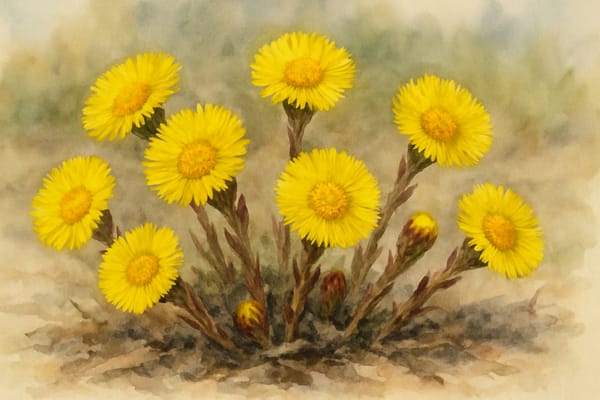Colt’s-foot (Tussilago farfara)
Colt’s-foot brings early spring colour, folklore, and herbal heritage to coastal gardens. Resilient and rich in history, it thrives in poor soils and supports pollinators—just keep its eager roots in check.


Colt’s-foot brings early spring colour, folklore, and herbal heritage to coastal gardens. Resilient and rich in history, it thrives in poor soils and supports pollinators—just keep its eager roots in check.


Colt’s-foot, with its golden daisy-like flowers emerging before its hoof-shaped leaves, has long been a symbol of early spring and a guardian of folk medicine traditions in the UK and Cornwall.
Ancient Herbal Legacy
Named from Latin tussis (cough) and ago (to drive away), coltsfoot has soothed sore throats, coughs, and asthma since Ancient Greece. In Britain, it was brewed, smoked, or applied in poultices—especially among Cornish tin miners, who valued it for easing lung ailments caused by dusty work underground.
Folklore and Magic
Colt’s-foot went by many names: coughwort, son-before-the-father (for its early bloom), and tushy-lucky. Folklore claimed it could protect against harm, predict futures in shiny leaf surfaces, or even summon a lost love when burned with intent.
Symbol of Apothecaries
In medieval Europe, coltsfoot’s bright flower became the emblem of apothecaries, and in Cornwall, it stood among the many plants woven into the region’s practical and magical healing traditions.
Ecology and Seasonal Meaning
As one of the first wildflowers of spring, coltsfoot offers precious early nectar to bees and pollinators. Its blooms brighten roadsides, cliffs, and wild coastal slopes—nature’s gentle signal that the growing season has begun.
Colt’s-foot thrives in challenging coastal soils, tolerating wind, salt, and dryness once established.
| Requirement | Details |
|---|---|
| Light | Full sun to partial shade |
| Soil | Moist, well-drained; clay, sandy, or gravelly soils |
| Water | Moderate; water young plants regularly |
| Salt Tolerance | High; excellent for coastal environments |
| Hardiness | Fully hardy in the UK |
Colt’s-foot is more than a bright face in early spring—it’s a healing herb, a coastal stabiliser, and a symbol of renewal rooted in folklore. Its ability to thrive in poor soils, fend off erosion, and support pollinators makes it a perfect, if spirited, companion for coastal gardeners with an appreciation for tradition and resilience.